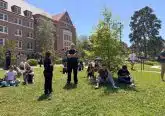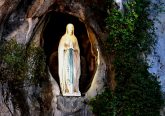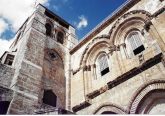USCCB abuse audit warns of complacency, cites ‘room for improvement’

IMAGE: CNS/USCCB
By Mark Pattison
WASHINGTON (CNS) — The annual report on the implementation of the U.S. bishops’ “Charter for the Protection of Children and Young People” warns against complacency in dioceses, and the firm contracted to conduct audits of dioceses and parishes said there was “plenty of room for improvement” in implementing two of the charter’s articles.
In remarks prefacing the report, Francesco C. Cesareo, chairman of the National Review Board, the all-lay group that tracks for the bishops how dioceses address clergy sexual abuse, said this year’s audit results “continue to demonstrate the progress that has been made in ensuring safe environments for children in the church.”
“The bishops need to be acknowledged for keeping the protection of children and young people in the forefront of their leadership by continually enhancing their efforts to comply with the charter,” Cesareo said.
However, he also warned that the U.S. church’s progress can “foster a false sense of security” that can “lead to complacency.”
“Such complacency can lead to a minimalist approach to the charter, which can be seen simply as a series of requirements that need to be checked off, as opposed to an implementation that renders the charter fully operative,” he said.
One example Cesareo gave was that “while every diocese has a diocesan review board, thereby complying with the charter’s requirement, in some cases the diocesan review board rarely meets or had not met in several years.”
In this year’s report, the Diocese of Lincoln, Nebraska, was again found to be not in compliance with the charter, as were the Chaldean Eparchy of St. Peter the Apostle in El Cajon, California; the Eparchy of Our Lady of Deliverance in Newark, New Jersey, for Syrians; the Armenian Eparchy of Our Lady of Nareg based in Glendale, California; the Ukrainian Eparchy of Stamford, Connecticut; and the Houston-based Personal Ordinariate of the Chair of St. Peter for former Anglican groups and clergy in North America joining the Catholic Church.
The report said the Lincoln Diocese would take part in the next audit, and that four of the other five ecclesial jurisdictions would as well, although which ones were not specifically named.
The Diocese of Santa Rosa, California, was judged to be not in compliance with two articles of the charter having to do with the education of children and those who minister to children about ways to create and maintain a safe environment for children and young people, and with evaluating background of clergy, candidates for ordination, educators, employees and volunteers who minister to children.
“Although the diocese may be providing training for the required categories of individuals, auditors could not accurately gauge participation by their parishes,” said the report, compiled by StoneBridge Business Partners. “Even though all others were deemed compliant with this article, there is still plenty of room for improvement.”
The new report said that between July 1, 2014, and June 30, 2015, 26 allegations of clerical sexual abuse were made by minors, and seven had been substantiated. All allegations were reported to civil authorities. The previous year, 37 allegations had been made, and 43 allegations had been made the year before that.
“While the number of allegations continues to decline, one instance of abuse is one too many,” said Deacon Bernie Nojadera, executive director of the U.S. bishops’ Secretariat for Child and Youth Protection, in the report.
Also in the same time period, 838 survivors of child sexual abuse by clergy came forward in 123 dioceses with 903 specific allegations, according to the report. The number of allegations is similar to 2013’s numbers; the 2014 numbers had been below 2015. The report attributed the increase to “six dioceses experiencing an influx of allegations during the 2015 audit year,” most commonly reported through from bankruptcy proceedings.
While the report stated that of the 838 victims, 386 of them, or 46 percent, “were offered outreach,” Deacon Nojadera, asked for clarification by Catholic News Service, said all 838 had been offered outreach, and that 386 had accepted the offer.
Of the 903 allegations — some of which date back to the 1940s — the investigation is ongoing in 398 of them. In 213 of them, an investigation has been unable to provide proof, often because the accused priest has died. Another 123 were substantiated, while 53 were unsubstantiated and the status of 116 of them is unknown, although some were referred to the provincial of the priest’s religious order.
The Center for Applied Research in the Apostolate, whose clergy abuse questionnaire to all U.S. dioceses and men’s religious orders also is part of the report, said that responses indicated that 81 percent of abuse victims were male and 19 percent female. Children ages 10-14 were the most common victims of abuse, at 49 percent, while 16 percent were under age 10, and 15 percent were ages 15-17; the age of the others was not known or submitted. Two percent of the allegations had to do with child pornography in the priest’s possession.
During the July 2014-June 2015 time period, dioceses, eparchies, and religious institutes reported paying out $153,619,544 for costs related to allegations. The diocesan costs of $141,283,794 is 33 percent higher than what was reported the year before, with most of the increase due to settlement payments to victims.
Dioceses, eparchies and religious orders also spent another $51,021,837 for child protection efforts. Over 2.4 million background checks were performed on adults at parishes and schools.
The report offered a number of cautions for dioceses.
“A significant number of allegations continue to involve international priests. Dioceses should take note of this and ensure they are utilizing the appropriate methods for evaluating their backgrounds,” the report said.
Turnover of personnel charged with charter implementation is another issue. “Staff turnover in diocesan and parish offices will become more pronounced as the first generation of leaders in our nation, especially those around since 2002 and 2003, begin to retire or move into new positions elsewhere,” the report said. “Dioceses should institutionalize policies and procedures rather than rely on historical knowledge of staff/employees alone.”
While the number of parish audits supplementing diocesan audits increased in 2015 from the year before, “most dioceses and all eparchies” opted not have StoneBridge conduct parish audits or surveys, the report added. Parish audits are optional but strongly encouraged, it said.
Untimely and incomplete reporting also proved to be limitations.
“Due dates were communicated several times throughout the audit workshops and via email,” the report said, but “dioceses and eparchies continue to submit their documents past the deadline.”
And “despite the frequent phone calls and emails we receive from diocesan/eparchial personnel throughout the year, we noted a significant number of incomplete and/or inaccurate documents submitted during this audit period. Several audit instruments were not completely filled out, which required the auditors to go through each item with the diocese/eparchy, resulting in less efficient use of time spent on-site.”
– – –
Editor’s Note: The full report is available at http://tinyurl.com/hp7a36v.
– – –
Follow Pattison on Twitter: @MeMarkPattison.
– – –
Copyright © 2016 Catholic News Service/U.S. Conference of Catholic Bishops. www.catholicnews.com. All rights reserved. Republishing or redistributing of CNS content, including by framing or similar means without prior permission, is prohibited. You may link to stories on our public site. This copy is for your personal, non-commercial use only. To request permission for republishing or redistributing of CNS content, please contact permissions at [email protected].













